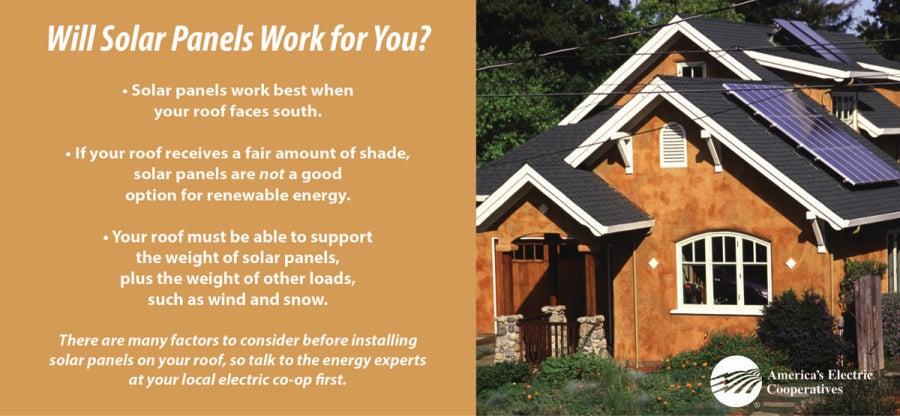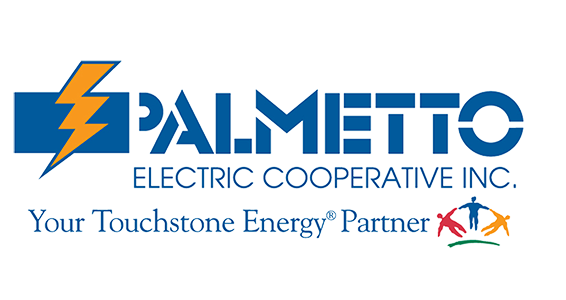Solar
As interest in renewable energy grows, some cooperative members are considering the purchase of a PV system. If you are interested in installing a PV system to replace some of the electricity that Palmetto Electric provides, you can find some helpful information below.
Palmetto Electric is ready to help you by providing information and answering questions. We want to give you the tools you need to make an informed decision about a PV system.
Before you decide to buy a PV system, however, you should examine the economics to determine whether such a system will lower your monthly electricity costs. The Energy Matters website can help you determine the annual operating cost of a PV system. For more information and general guidelines, you can also visit South Carolina's Source for Solar Information.
Solar Calculator: Have you ever wondered what size solar PV system you need or how much it would cost? Use this user-friendly solar energy calculator to estimate the cost and size of a solar array in your area.
If you have questions, please feel free to CONTACT US.

For many, the use of solar panels to generate electricity is a recent technological development. When I think of photovoltaic (PV) solar panels, images of early NASA vehicles in outer space immediately come to mind. Indeed, America’s first permanent satellite, Explorer I, was powered by PV panels in 1958.
However, the use of solar energy dates back to 1767 when a Swiss scientist named Horace-Benedict de Saussure built an insulated, glass-faced box, generating temperatures of up to 230 degrees from sunlight. His invention was dubbed the “solar oven.”
Fast-forward to today, and nearly everyone is aware of solar. Yet, PV has remained one of the most expensive forms of electricity. People always ask why this is the case when the fuel is “free.” It’s because the equipment is expensive, and the sun doesn’t always shine. While equipment prices have dropped dramatically, the output of commercially available panels ranges from 5 to 19 percent (15 percent is common) of the theoretical limit, assuming there were never clouds and the sun was at high noon 24 hours a day.
So, is solar electricity right for you? The short answer is, “It depends.” How’s that for an ambiguous answer? But it truly does depend on a number of factors. The first thing you should consider is why you want to go solar. If it is for backup power in an emergency, stop here. PV systems are tied to the grid for safety reasons. When the power goes out, the PV array shuts down.
If it is for environmental reasons, read on.
Your next step is to contact Palmetto Electric to discuss your plan. Talk to our energy experts, and let us help you decide what makes the most sense for your home. A south-facing roof is typically the preferred direction² for the placement of solar panels. Do trees shade the roof at any time? Next to darkness, shade is the natural enemy of solar panels. Is your roof structure capable of accepting the weight of the panels and any other load, say wind and snow? Are there any neighborhood or local regulations prohibiting solar panels?
Now to the nitty gritty. Grab your electric bills from the past year and see how many kilowatt-hours (kWh) your home has used. Palmetto Electric can assist with this task. The typical American home PV system produces 5 kWh per hour. How much of your home’s annual use can be covered?
Then comes the cost. The 5 kWh system has an average cost of $24,650 before any incentives. The most common incentive is a 30 percent tax credit from the Federal Government. Then there are savings in reduced energy use costs and the potential benefit of any electricity sold back to Palmetto Electric. Calculations have shown paybacks between seven and 15 years.
If the cost of the system is too steep, you might be able to sign a contract with a solar company who will install the system at no cost but take all the incentives and charge a monthly fee.
If you want more information, reach out to Palmetto Electric. If you decide to talk to a contractor, be sure to check references. Increased interest in solar has spawned a large number of sellers who have little knowledge in PV installations. Caveat emptor is the rule to obey here.
¹To provide power during an outage you need batteries to store the electricity, plus advanced controls that will safely allow your system to island or supply power only to your home. Such systems are usually equal to the cost of the PV system itself.
²Recent research is showing western facing roofs might be better choices for generation during peak demand hours. http://costofsolar.com/best-direction-to-face-solar-panels-south-or-west/
Tom Tate writes on cooperative issues for the National Rural Electric Cooperative Association, the Arlington, Va.-based service arm of the nation’s 900-plus consumer-owned, not-for-profit electric cooperatives.
